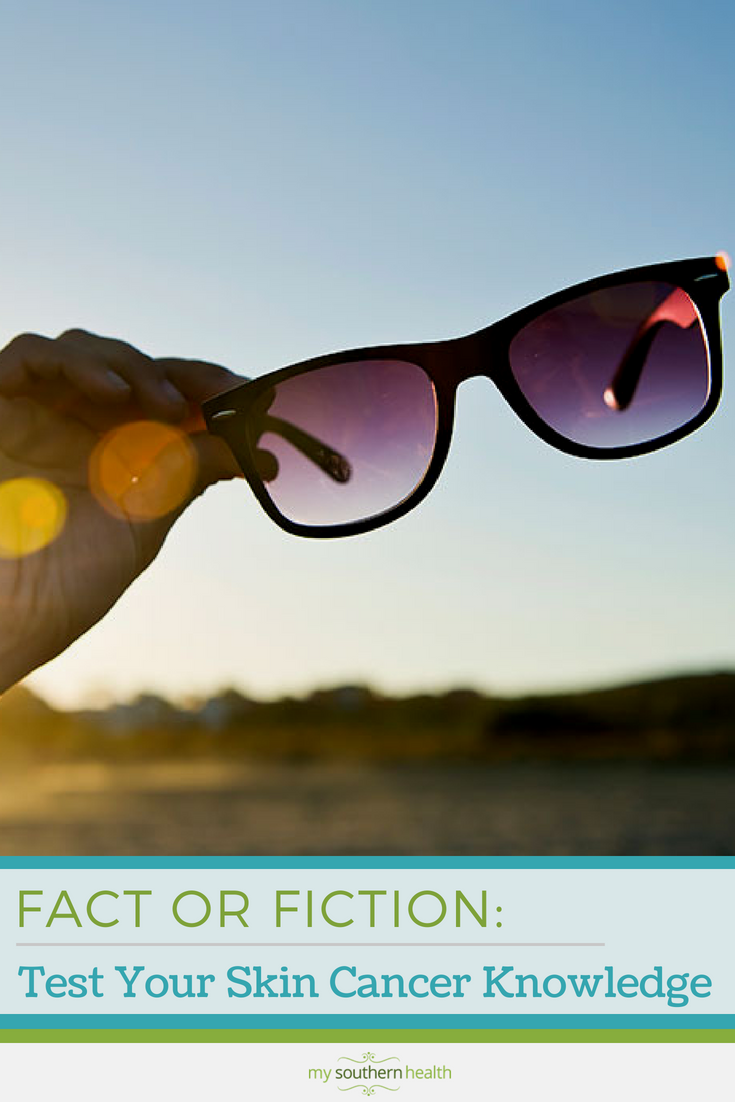A dermatologist addresses common misconceptions around the sun and your skin.
Our relationship with sunscreen has grown from the days of the Coppertone girl. Sun protection isn’t reserved for the beach anymore: It’s in your daily ChapStick, moisturizer and even your clothes.
But how well do you rank when it comes to skin cancer myths? May is Melanoma/Skin Cancer Detection and Prevention Month; we talked with the director of dermatologic surgery at Vanderbilt University Medical Center, Michel McDonald, M.D., about some common skin cancer myths and facts.
Take our true/false quiz, then check below to find the answers and more details on the fact or myth, courtesy of McDonald.
- My routine doesn’t include outdoor activities, so I’m not at risk.
- True
- False
- Tans help shield the skin from damage, and dark-skinned people are not at risk for skin cancer.
- True
- False
- Skin checks should be self-administered, as well as done by a physician.
- True
- False
- Younger people don’t get skin cancer; it only develops in older age.
- True
- False
- I need to wear sunscreen even if it’s a cloudy and/or winter day.
- True
- False
- Skin cancer only develops on parts of my body that have received too much sun.
- True
- False
- Only putting on sunscreen as part of my morning routine will protect me from skin cancer.
- True
- False
Answers:
- False: Even if you are not routinely doing outdoor activities, you are exposed to UVB rays doing normal daily activities, such as walking to your car. UVA rays can penetrate window glass. It is always beneficial to have sunscreen coverage even if you aren’t engaging in outdoor sports or recreation.
- False: A tan means the skin has been damaged, not that it has been protected. The tan itself is a sign that the damage has already occurred. Darker-skinned individuals can still develop skin cancer from ultraviolet light damage.
- True: By the time you see your physician, the area may already be cancerous. Regular skin checks, both done on your own and by a physician, are the best way to catch a lesion early. Doing a self-exam of your skin every month and having a physician do a skin check annually (or more frequently for higher-risk patients) will allow the identification of changing moles or lesions.
- False: Melanoma — the skin cancer with the most potential to be fatal — is the most common type of cancer in young adults aged 25-29 and the second most common in those aged 15-25. The two most common forms of skin cancer, basal and squamous cell carcinoma, are related to cumulative sun exposure; therefore, they occur more frequently in the elderly. They do, however, also occur in much younger patients. A young age does not protect you from getting skin cancer.
- True: While cloudy days and winter days may mean less overall UVA and UVB exposure than bright, sunny summer days, exposure is still occurring, and sunscreen is always recommended.
- False: Melanoma can develop in the back of the eye, the genital region and other areas that never receive sun exposure.
- False: While McDonald advises applying at least SPF 30 every morning on your face, neck and the back of your hands, she says putting on sunscreen correctly and reapplying frequently is crucial to protection. You should reapply every two hours and also be sensible about sun exposure, avoiding the sun between 10 a.m. and 2 p.m., if possible.


Free skin screening
Vanderbilt Dermatology in collaboration with the Nashville Dermatology Society is offering a Free Skin Cancer Screening this Saturday, June 2. No appointment is needed and walk-ins are welcome.
Time: 9 a.m. to noon
Where: Vanderbilt Dermatology One Hundred Oaks, 719 Thompson Lane, Suite 26300
No matter your age, sex, or skin color, everyone is at risk for developing skin cancer. Risk factors include:
- Sunlight exposure
- Blistering burns in childhood (even one can double the risk of melanoma)
- Indoor tanning beds
- Having greater than 50 moles
Skin cancer is common:
- One in five Americans will develop a skin cancer in their lifetime.
- Melanoma is the most common form of cancer in ages 25-29.
- One American dies from melanoma every hour.
- Melanoma rates have doubled from 1982-2011.
Additional notes:
It is recommended that self-skin exams are done every month looking for new spots or spots that might be changing in size, shape or color. Sunscreen with an SPF of 30 or higher should be worn daily. A total body skin exam with a dermatologist should be performed annually.

